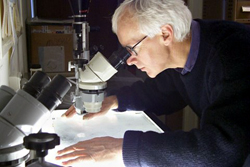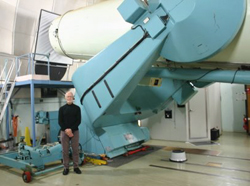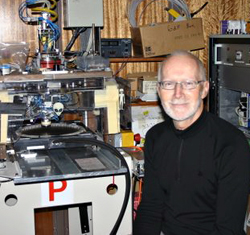EPOXI
Two intriguing investigations -- One flight-proven spacecraft
Malcolm Hartley
Malcolm Hartley
Comet Discoverer

Where are you originally from?
I was born in Bury, Lancashire, England on 15 February 1947. From a young age, I was fascinated by astronomy and had an uncle with a 3-inch refractor telescope, which we were able to see the craters on the moon; the various phases of Venus; the inner satellites of Jupiter; and projected images of the sun showing sunspots.
I studied at the University of Edinburgh from 1966 to 1970 and graduated with an Astrophysics degree. In 1976, I came to work at the UK Schmidt in Australia when the telescope was undertaking the Southern J Sky Survey.1

Is comet hunting a career or hobby for you? How did you get started?
As part of the quality control of plates taken in this survey and later surveys (Equatorial J, Second Epoch R) the plates were routinely scanned by eye using x10 magnifier. Numerous new asteroids and comets were discovered as a result as well as a host of other interesting objects. So, comet hunting wasn't a career for me but it was very exciting to discover one and realize that your name was going to be attached to it. I scanned the survey plates for maybe 10 hours a week over a period of 15 to 20 years.
To date, how many comets have you discovered?
To date, I've discovered about 10 comets over the years (I don't actually keep a log). Since we no longer "do" photography with the Schmidt Telescope, the chance of me discovering any more are about zero. Rob McNaught is now the top discover with the aid of the Uppsala Schmidt engaged in the Near Earth Observation (NEO) survey.
The last photographic survey to be undertaken with the UK Schmidt was a Halpha survey of the galactic plane.2 During the scanning of these films a team of astronomers headed by Prof. Q.A. Parker (Macquarie University, Sydney) discovered over 1000 new planetary nebulae. I discovered over 100 of these PN's.

What would you like to see the EPOXI mission find?
It's a big thrill knowing that the EPOXI mission will be visiting the comet I discovered. I hope that the upcoming, November 4, encounter turns out to be worthwhile for both the mission and NASA. The mission has been brilliant to date and it would be great to end it with bang (not literally). Since comets and their composition play a major part in our studies of the Solar System, discovering the signature of water and other volatiles through spectral analysis of the comet's surface and coma would add weight to discoveries already made from the analysis of Deep Impact Tempel 1 data. The Stardust-NExT flyby of Tempel 1 next February will be the icing on the cake for NASA's brilliant comet missions and a special birthday present for me.
For young people who are interested in just getting started in using telescopes what advice can you offer them?
I dreamt that I might be an astronomer one day (or even an astronaut) but never imagined hunting for or discovering a comet. For future astronomers or anyone who is interested in searching the skies, you don't need to spend a lot of money on sophisticated instrumentation. All you need to do is read around the subject, join an astronomy club, and get out into the countryside away from the city lights to see the dark sky in its true glory. If you really get hooked into the astronomy bug, visit the southern hemisphere for the best views of the galactic centre and the Magellanic Clouds. You'll have a lot of fun and meet a host of interesting characters while doing it.
Images courtesy of Malcolm Hartley and used with permission.
1 Southern Sky Survey: A photographic survey of the sky south of declination -17°, produced jointly by the European Southern Observatory's 1-m Schmidt camera and the 1.2-m United Kingdom Schmidt Telescope at Siding Spring. Both telescopes have the same focal length as the 1.2-m Oschin Schmidt, which produced the northern hemisphere Palomar Observatory Sky Survey, so the scale of the plates in each survey is identical. The Southern Sky Survey consists of 606 pairs of red-sensitive and blue-sensitive plates; the red plates were taken in 1978-90 with the ESO Schmidt and the blue plates 1974-87 with the UK Schmidt.
2 The Southern H-Alpha Sky Survey Atlas is the product of a wide-angle digital imaging survey of the H-alpha emission from the warm ionized interstellar gas of our Galaxy.
